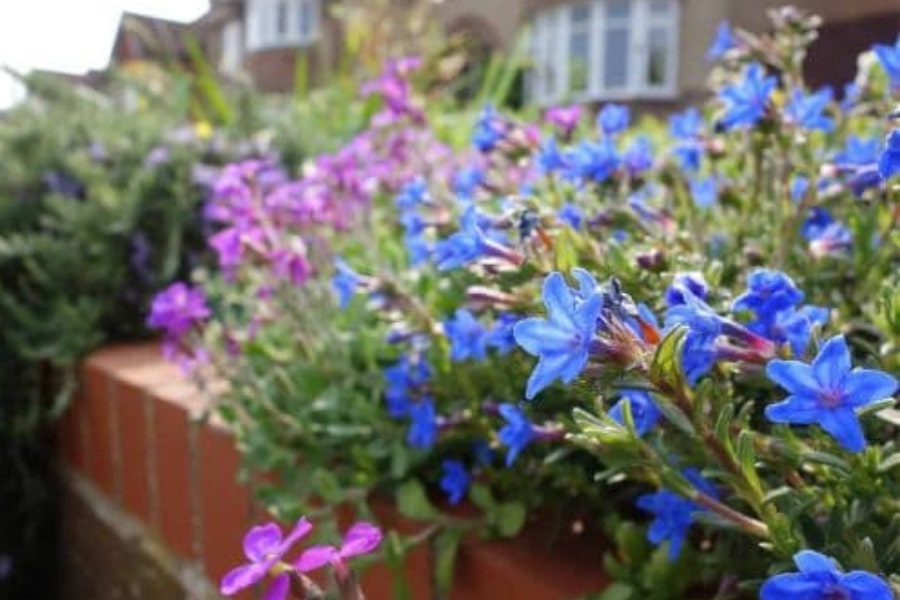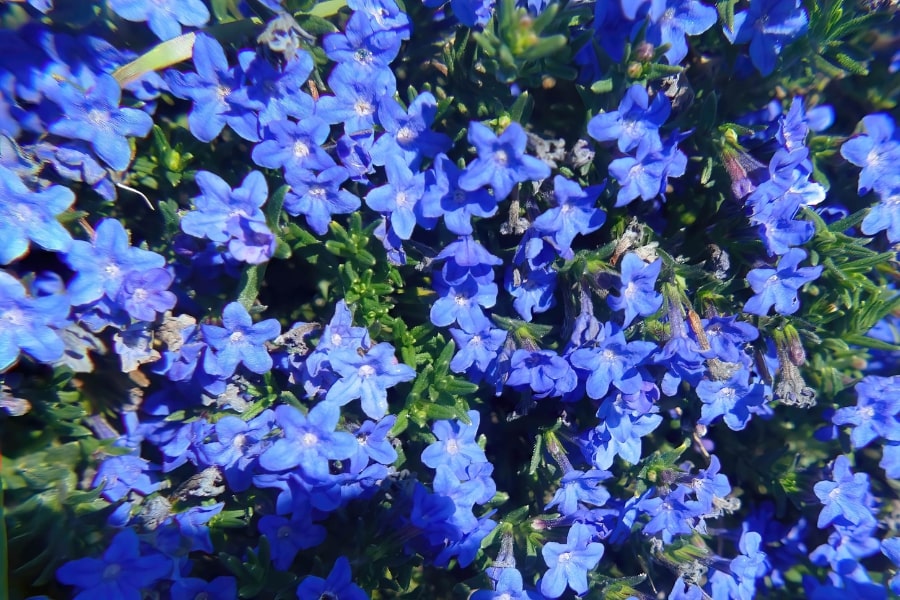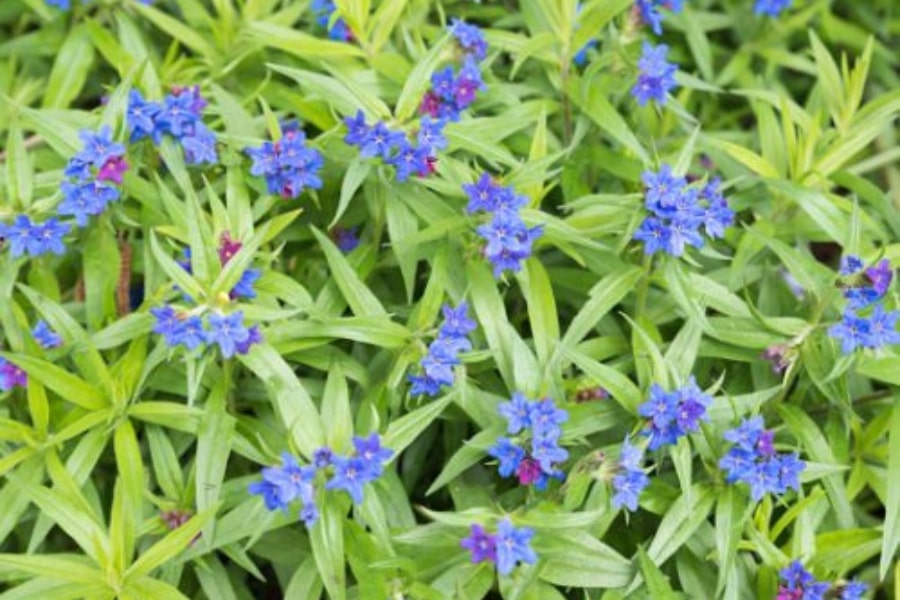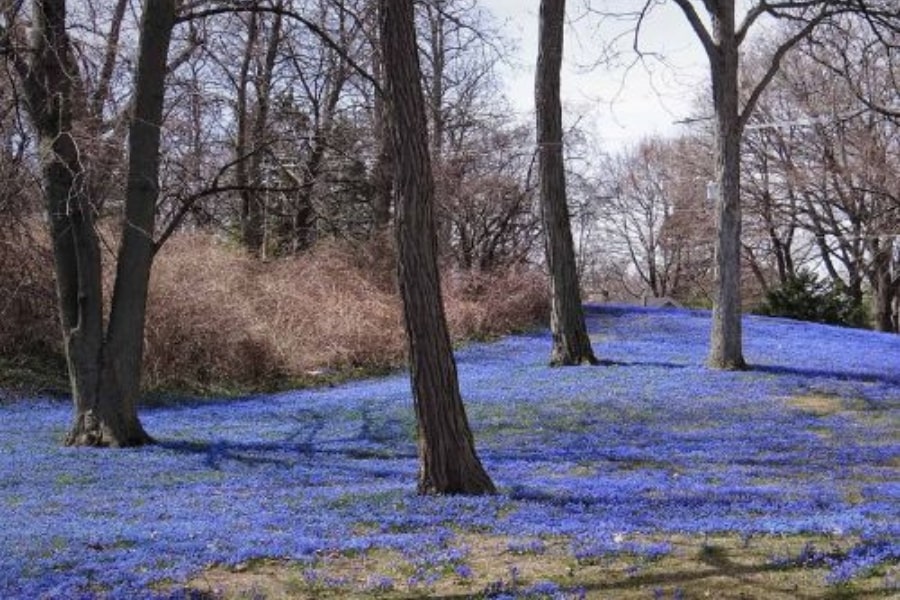Derived from the Greek words “lithos” meaning stone, and “doron” meaning gift, Lithodora is a genus of flowering plants known for its stunning blue flowers and evergreen foliage. Lithodora is part of the Boraginaceae family and includes roughly 20 species, most of which are native to the Mediterranean region. Typically, Lithodora forms low-growing, spreading evergreen shrubs that provide a carpet of vivid color in the garden.

Our Selection of Lithodora
At Martin Garden Center, we grow and sell only the Grace Ward variety of Lithodora in 4″ containers. We usually see this plant in early March. It is grown by our vendor every 6 weeks or so, thus allowing us to have it in stock regularly, though not consistently, through late fall. Because it is an herbaceous perennial, it is not grown in the winter.
Growing and Caring For Lithodora
Most Lithodora species are hardy and can withstand a range of temperatures. However, they generally perform best in climates with mild winters and warm, dry summers. Some protection may be necessary to shield the plants from extreme cold in regions with harsh winters. These plants prefer full sunlight but can also tolerate partial shade. In their natural habitat around the Mediterranean region, Lithodora species often grow in sunny, rocky environments with well-draining soil. Providing them with a sunny location will typically result in healthier plants and more prolific blooming.
These plants thrive in well-draining, slightly acidic to neutral soils. Lithodora’s natural habitat on rocky slopes and cliffs underscores its preference for soils with excellent drainage. Amending the soil with organic matter can enhance fertility and improve overall soil structure. Planting in raised beds or rock gardens can further facilitate drainage. While Lithodora is drought-tolerant once established, it benefits from regular watering during dry spells, especially in the absence of natural rainfall. However, overwatering should be avoided to prevent root rot.
Pruning is generally minimal for Lithodora. However, removing spent flowers can encourage prolonged blooming and maintain a tidy appearance. Trimming back excessive growth in early spring can promote bushier, more compact plants. Lithodora plants generally do not require heavy fertilization. A balanced, slow-release fertilizer in spring can provide the nutrients for healthy growth. In regions with harsh winters, providing some form of winter protection, like mulching around the base of the plant, can help shield Lithodora from extreme cold temperatures.
While Lithodora is generally resilient to pests and diseases, occasional issues such as aphids or powdery mildew may arise. Regular monitoring and appropriate horticultural practices, such as proper spacing and good air circulation, can mitigate these problems.

Leavers and Flowers
The foliage of Lithodora has small, elliptical leaves that often have a silvery or grayish-green hue. These leaves are typically covered in fine hairs, giving the plant a textured appearance. The evergreen nature of Lithodora’s leaves ensures that the plant maintains its ornamental appeal throughout the year, even in colder seasons. The leaves are crucial in creating a dense, compact growth habit, making Lithodora an excellent choice for ground cover and rock gardens.
The true spectacle of Lithodora, however, lies in its vibrant and captivating flowers. The blossoms, shaped like funnels with five distinct lobes, come in an intense and striking blue color often likened to a clear sky’s vividness. These flowers appear in terminal clusters, creating a profusion of blue hues that can transform a garden into a mesmerizing display of color. Some species may also produce pink or purple flowers, adding variety to Lithodora’s floral palette.

Uses in the Garden
The vibrant blue flowers of Lithodora also make it an attractive option for borders and edging in garden beds. Lithodora adds a touch of elegance to the landscape by planting along pathways or framing other flowering plants. Lithodora’s natural affinity for rocky environments makes it an excellent choice for rock gardens. These plants’ low-growing, spreading habit creates a carpet of color that complements the rugged textures of rocks and stones. For those with limited garden space or looking to create a mobile display of color, Lithodora can thrive in containers. Ensure the pot has proper drainage and select a well-draining potting mix to prevent waterlogging.

Frequently Asked Questions
Do Deer Eat Lithodora?
Lithodora is generally considered deer-resistant due to its slightly hairy, tough-textured leaves and low-growing habit. While no plant is entirely deer-proof, deer tend to avoid Lithodora in favor of more tender and palatable options.
Does Lithodora Come Back Every Year?
Yes, Lithodora is a perennial in most climates, meaning it comes back year after year. It thrives in USDA zones 6-9, where it remains evergreen in milder winters but may die back slightly in colder regions. With proper care, including well-drained soil and full to partial sun, Lithodora will continue to spread and produce its vibrant blue flowers each spring and summer. In harsher winters, a layer of mulch can help protect the roots and encourage healthy regrowth in the spring.
Is Lithodora Poisonous To Dogs?
Lithodora is not listed as beign toxic to dogs, but it’s always best to exercise caution with any plant. While there are no known reports of serious poisoning, ingestion of large amounts could potentially cause mild stomach upset in pets.
